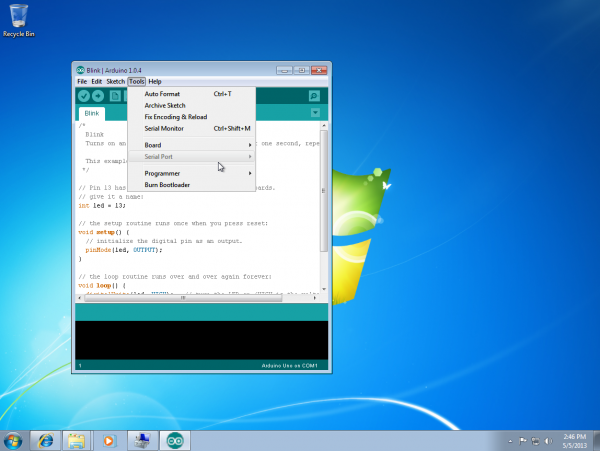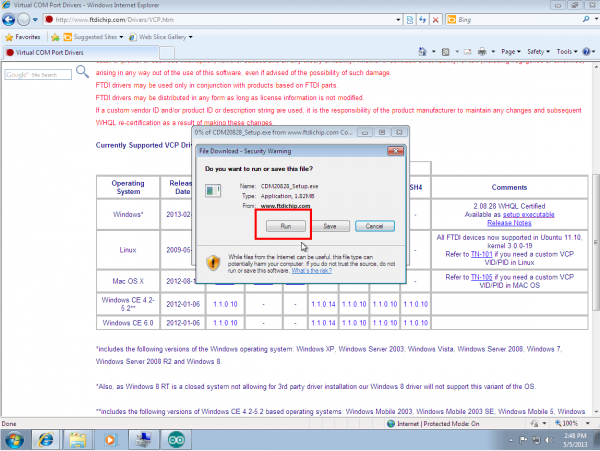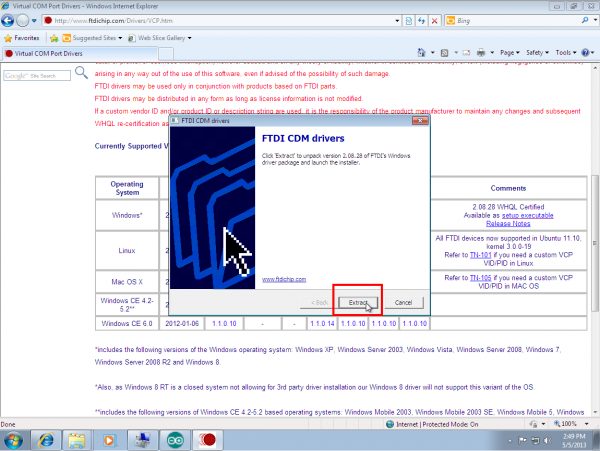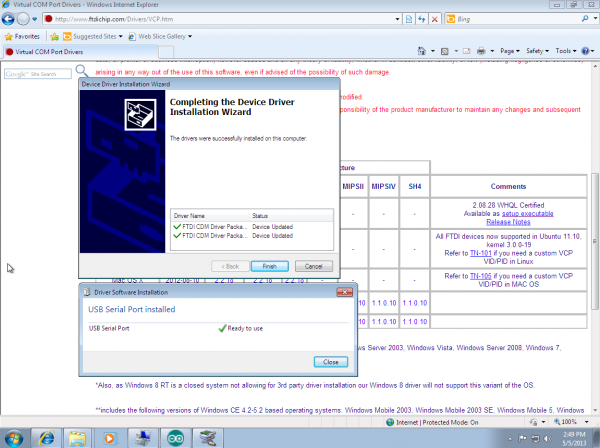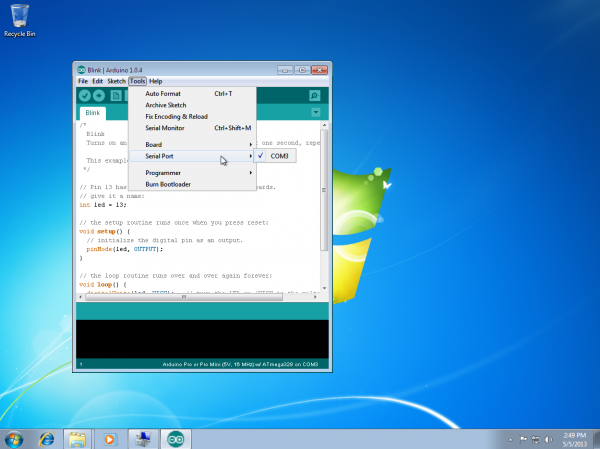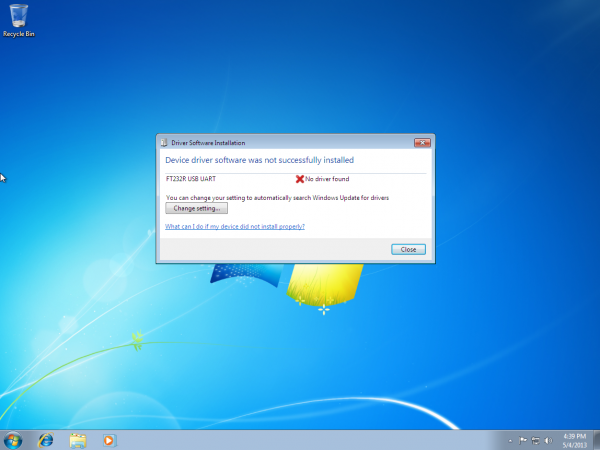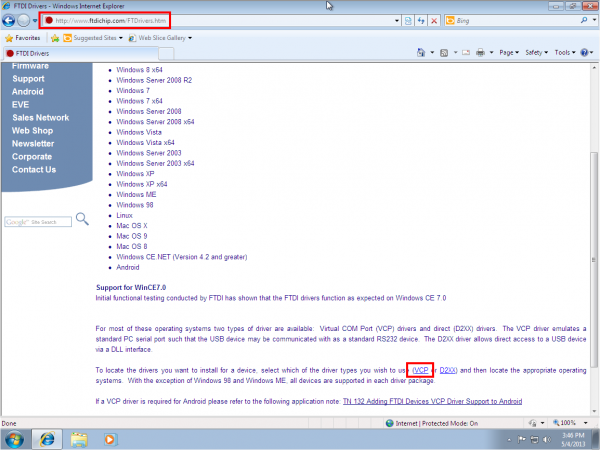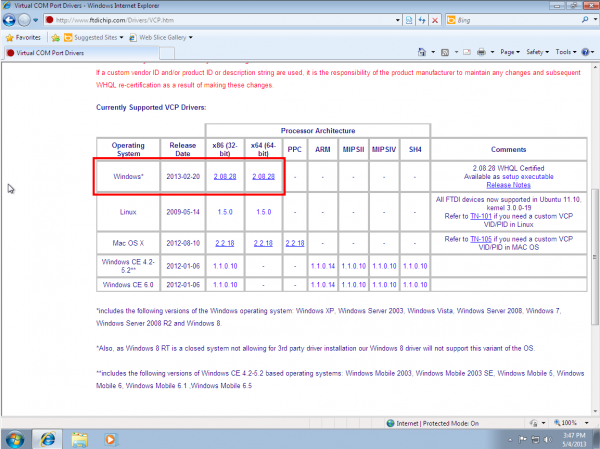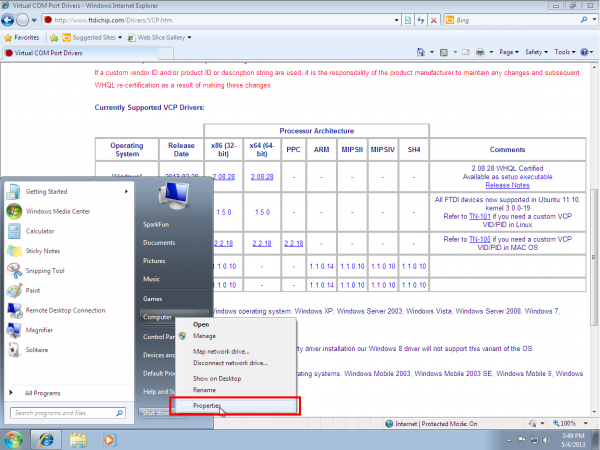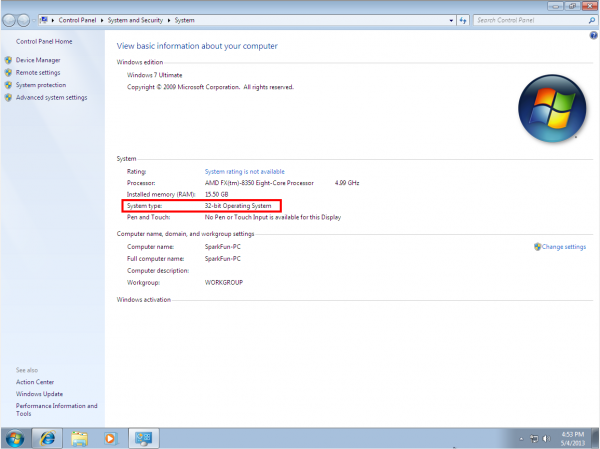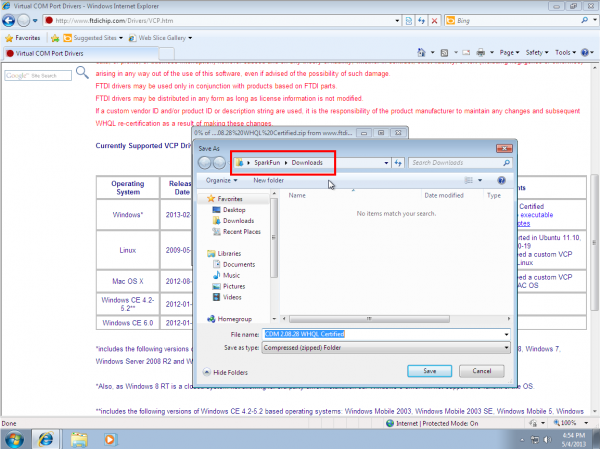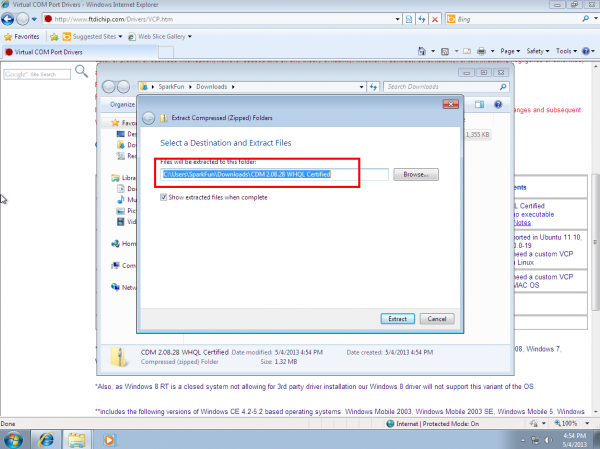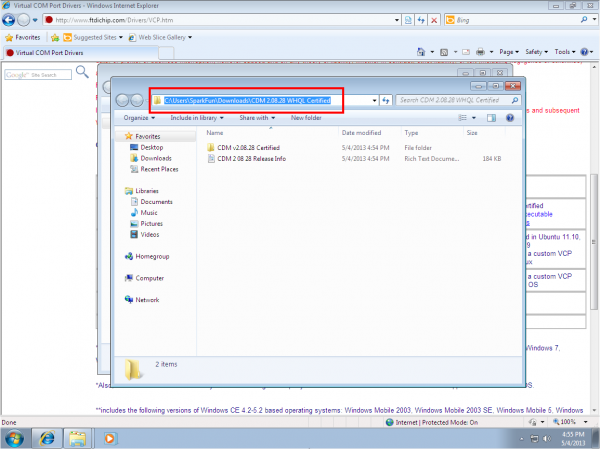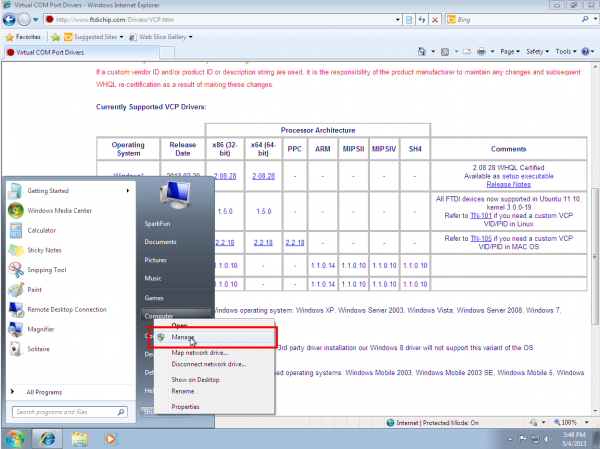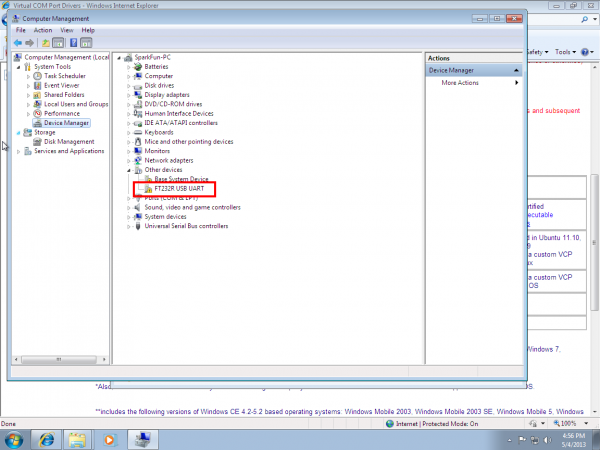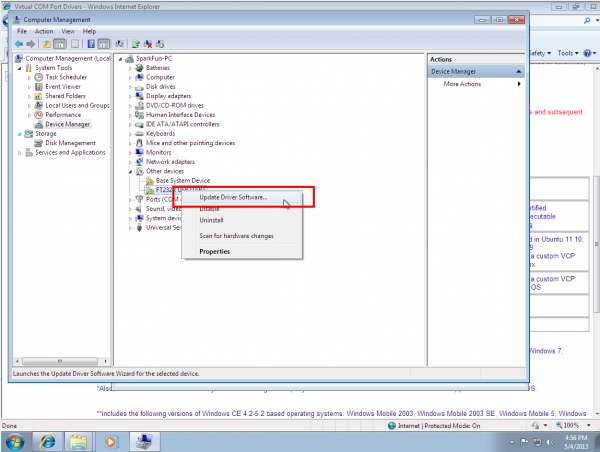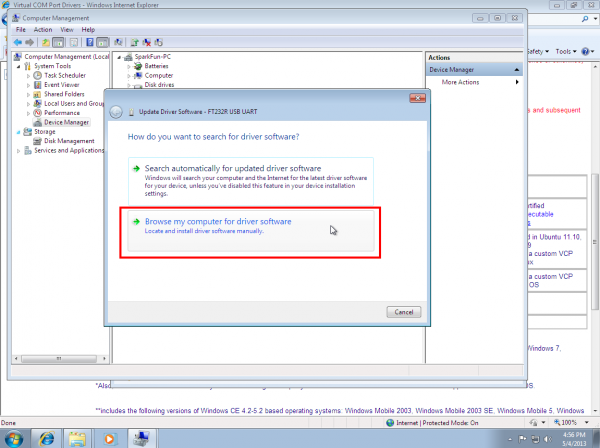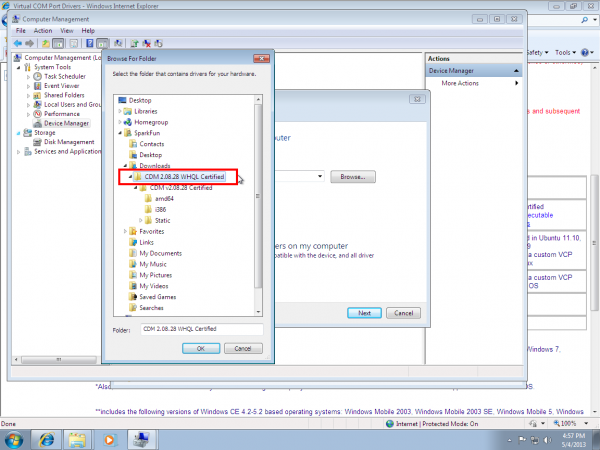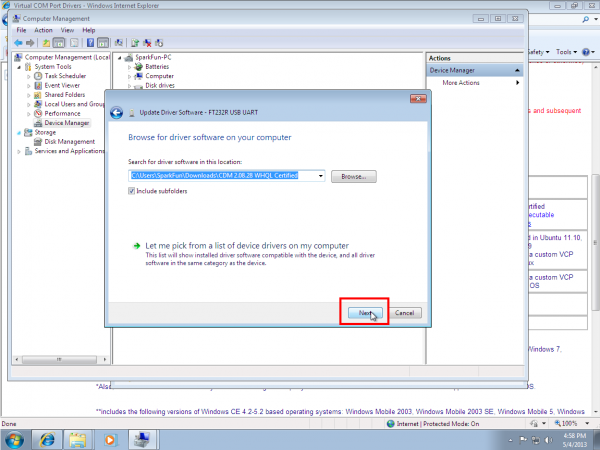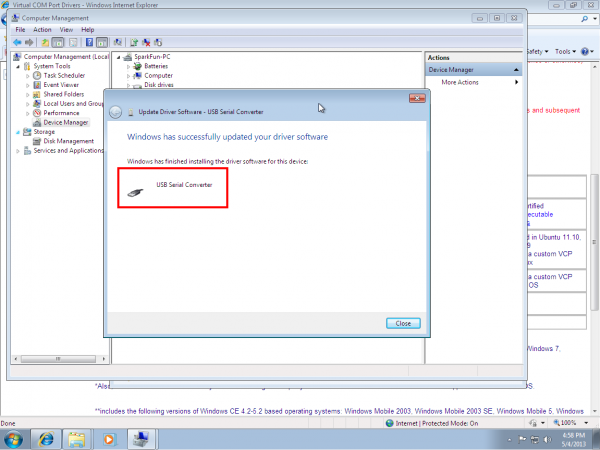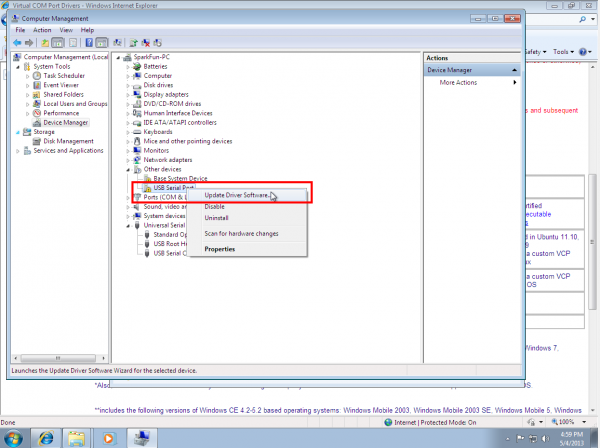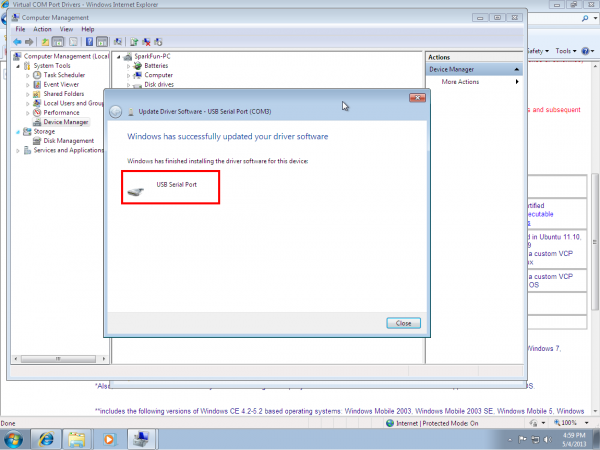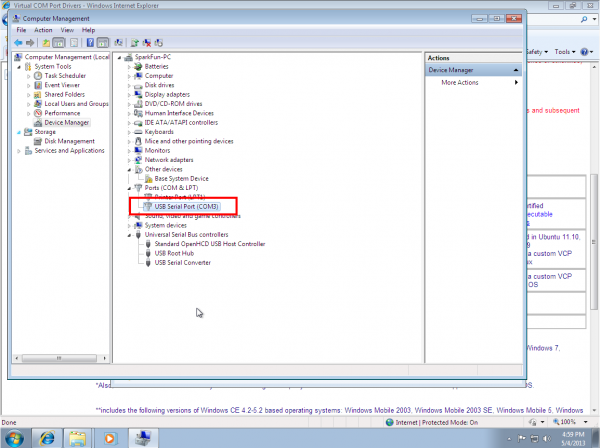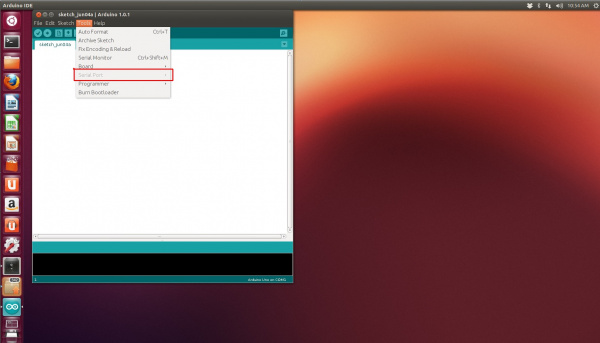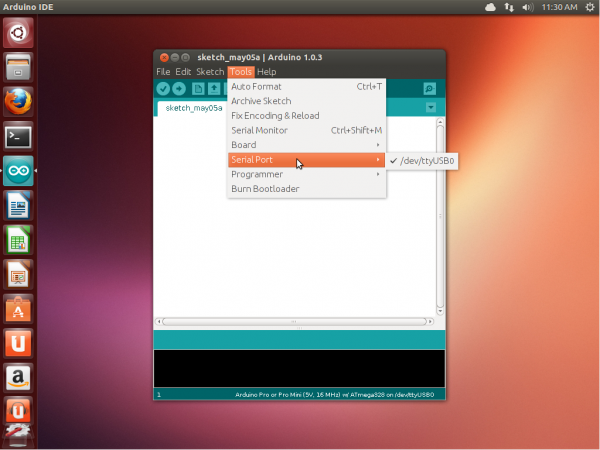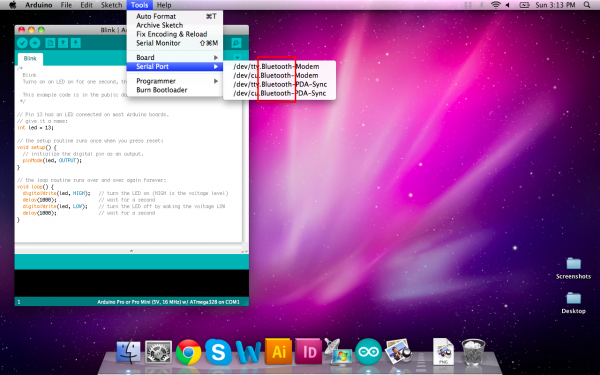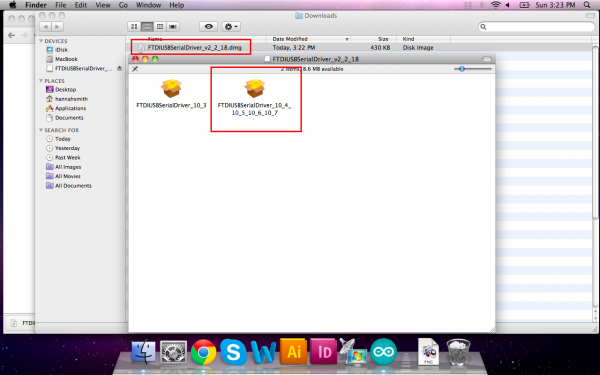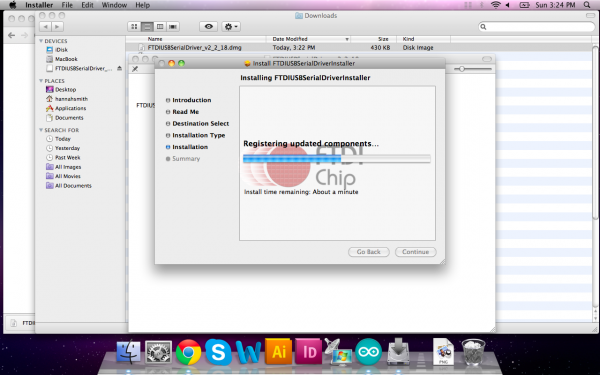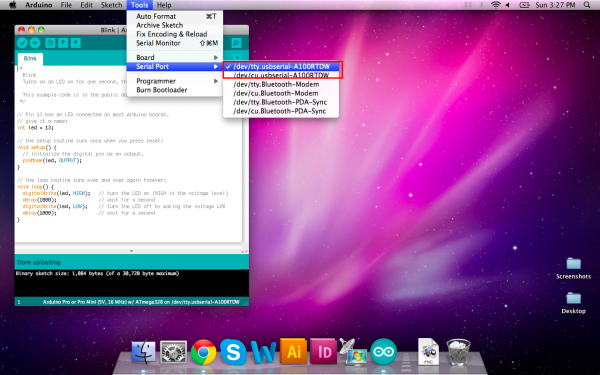How to Install FTDI Drivers a learn.sparkfun.com tutorial
Introduction
In this tutorial, we’ll show you how to install FTDI drivers on multiple operating systems. Although this tutorial was written using Windows 7, Mac OS X 10.6, and Ubuntu 13.04, the process should be very similar, if not exactly the same, for other versions/variations of these operating systems.
Suggested Reading
Before you begin this tutorial, you should have the Arduino IDE installed on your computer. Check out our Installing Arduino tutorial for a step by step guide.
Here are some other tutorials and concepts you may want to familiarize yourself with before reading this tutorial:
- What is an Arduino?
- Serial Communication
- RS-232 vs TTL Serial Communication
- Logic Levels
- Connector Basics
Alright let’s get to work! Check out the navigation box on the left side of this page. You can visit the next section to learn more about the FTDI Basic and why you need the FTDI drivers, or you can skip straight to the operating system of your choice!
Meet the FT232RL
The FT232RL is one of the more commonly used ICs used to convert USB signals to UART signals. This process is very handy in that it allows you communicate with and upload code to an Arduino or other microcontroller without the need for an external programmer. SparkFun carries a board called the FTDI Basic that conveniently breaks out the necessary pins on the FT232RL to perform these actions.
SparkFun’s 5V FTDI Basic. Notice the IC—FT232RL.
There are a few different flavors of the FTDI Basic:
If you are using a 5 volt device, you will need the 5 volt FTDI. If you have a 3.3 volt device, you guessed it, use a 3.3 volt FTDI. LilyPad boards all operate on 3.3V.
We also carry a complete breakout board for the FT232RL should you need access to more pins than the FTDI Basic provides.
Here is a list of some SparkFun products that require the use of an FTDI Basic, come with an FTDI Basic, or have an FT232RL chip on board:
- RedBoard
- Arduino Pro 5V and 3.3V
- Arduino Pro Mini 5V and 3.3V
- Mega Pro 5V and 3.3V
- Mega Pro Mini
- LilyPad Main Board
- LilyPad Simple Board
- Arduino FIO
- Protosnap – Pro Mini
- Protosnap – LilyPad Development Board
- Protosnap – LilyPad Development Board Simple
There are also some legacy Arduino boards that use the FT232RL. The Arduino Diecimila and Duemilanove main boards along with the original Arduino Mega all use the FT232RL IC. If you have one of these older versions, you’ll want to use the FDTI drivers as well. For a complete list of all Arduino boards, check out this page. Newer versions of Arduino boards, such as the Uno, use a different communication IC, and they will not be covered in this tutorial.
Now that you know why the FTDI Baisic is important and what products it is used for, let’s learn how to install the drivers.
Windows - Quick and Easy
Note: The screen shots in this tutorial are from Windows 7. The process should be very similar for other versions of Windows.
Note for Educators: You will most likely need to obtain administrative privileges from your network or IT administrator in order to install these drivers.
1.By default, windows does not have FTDI drivers installed. If you plug in your FTDI, open the Arduino IDE, go to ‘Tools –> Serial Ports’, and see nothing, you need the drivers! Let’s go get them!
2.Head over to the FTDI website, click ‘Drivers’ on the left, and then click ‘VCP Drivers’. This stands for Virtual Com Port.
3.Now choose the ‘setup executable’ link under the ‘Windows’ row.
4.There is no need to save this file. Choose ‘Run,’ once it is has finished downloading.
5.Choose ‘Extract,’ and continue through the installation until it finishes.
6.If everything was successful, you should see some nice green check marks, indicating success! If things didn’t work out, try the next section of this tutorial: Windows – In Depth.
7.Open up the Arduino IDE, and go to ‘Tools –> Serial Port’. If you now have a COM port, congratulations! Again, if something went wrong, either retry this tutorial or give Windows – In Depth a try!
Windows - In Depth
Note: The screen shots in this tutorial are from Windows 7. The process should be very similar for other versions of Windows.
Note for Educators: You will most likely need to obtain administrative privileges from your network or IT administrator in order to install these drivers.
1.Plug in your FTDI using a USB cable. Windows doesn’t have the correct drivers, so let’s find them!
2.Navigate to the FTDI website, and choose the ‘VCP’ (Virtual Com Port) option near the bottom.
3.Now choose either the 32 bit version or the 64 bit version. Not sure which you have? The next steps will go over how to find that information. If you already know which version you are running, you may skip the next two steps.
4.Open the start menu, right-click on ‘Computer,’ and left-click on ‘Properties’.
5.Look under ‘System type,’ to see which version you have.
6.Now go back to the FTDI site, right-click on the correct version, and save it to your computer. Remember where the files are saved. We’ll need them in the next step.
7.Navigate to the folder containing the files. They will be inside of a .zip file, so you’ll need to extract them. Right-Click on the .zip file, and choose ‘Extract All…’ When the next window appears, as shown above, pay attention to where it is extracting the files. Make sure that ‘Show extracted files when complete’ is checked, and click ‘Extract’.
8.When the extraction is complete, the folder is opened. Again, take note of this folder location. This is the one containing the drivers.
9.We’re almost there! Open the start menu, right-click on ‘Computer’, and left-click on ‘Manage’. You will need administrator rights to do this. If you aren’t an administrator on your computer, talk to the person who is and have them enter their credentials.
10.Left-click on ‘Device Manager’ in the leftmost column. Here is where we see the offending hardware. It has an exclamation mark next to it.
11.Right-click on ‘FT232R USB UART,’ and left-click ‘Update Driver Software…’
12.Now choose ‘Browse my computer for driver software’.
13.Left-click ‘Browse,’ and navigate to the location of the extracted files. Choose the extracted folder. There is no need to search any futher in the folder. Then left-click ‘OK’.
14.Make sure ‘Include subfolders’ is checked (very important!), and left-click ‘Next’.
15.After a moment, you will see a success message! Left-click ‘Close’.
16.The Device Manager page will refresh and you will see a new item with an exclamation mark named ‘USB Serial Port’. You will need to install a second driver for the same device. Follow the steps 1-15, as before, and use the same driver folder too!
17.Once those steps are complete, you will see another success message! Left-click ‘Close’.
18.The Device Manager Page will refresh again and show ‘USB Serial Port (COMxx),’ where xx = some number. Congratulations, you now have the proper FTDI drivers and can begin to use your device!
Note: You should only need to go through this process once. Every subsequent FTDI device you plug in should now have these drivers associated with it. However, if this is not the case, you can follow these instructions again for other devices.
Note: If you have more than one FTDI device plugged in to your computer at the same time, all of the devices will show up under this menu. To figure out which device is which, look under the ‘Serial Port’ menu. Take note of the names of each device. Then unplug the device you want to use. Go back to the ‘Serial Port’ menu. The device you unplugged should no longer be listed. That is the device you want. Plug it back in, and select the device that has now reappeared. You can also check the Com port number in the Device Manger to see which device is associated with each Com port.
Linux
Note: The screen shot in this tutorial is from Ubuntu 13.04. The process should be very similar, if not exactly the same, for other versions/variations of this operating system.
1.Plug in the FTDI device to a USB cable.
2.When you download the Arduino IDE in Linux, the download comes with the FTDI drivers bundled with the IDE. However, if you just open Arduino from the desktop, you’ll notice that, if you click on ‘Tools’, the ‘Serial Port’ option is grayed out.
3.To get around this, you need to open Arduino as Root using the terminal.
sudo arduino4.Then, enter your password.
5.Arduino should open, and this time the ‘Serial Port’ menu is available.
6.The FTDI device will show up under this menu. It should be named /dev/ttyUSB0. The number may vary depending on how many USB devices you have plugged into your computer. That’s all.
Note: If you have more than one FTDI device plugged in to your computer at the same time, all of the devices will show up under this menu. To figure out which device is which, look under the ‘Serial Port’ menu. Take note of the names of each device. Then unplug the device you want to use. Go back to the ‘Serial Port’ menu. The device you unplugged should no longer be listed. That is the device you want. Plug it back in, and select the device that has now reappeared.
Mac
Note: The screen shots in this tutorial are from OS X 10.6. The process should be very similar, if not exactly the same, for other versions of Mac OS X.
Note for Educators: You will most likely need to obtain administrative privileges from your network or IT administrator in order to install these drivers.
1.Most of the time, when you install Arduino on Mac OS X, the drivers are installed automatically. However, if there was a problem with the installation and you don’t see any options that include ‘usbserial’ under the ‘Tools –> Serial Port’ menu, then you will need to install the drivers.
2.Head over to the FTDI site. Look on the left side for ‘Drivers,’ and then choose ‘VCP Drivers’.
3.Now we need to determine if you need the x86 or x64 bit version of the drivers. Click on the apple icon in the top left of the screen, and choose ‘About this Mac’.
4.Check under ‘Processor’ to see which version you have. Follow the chart below to determine which drivers to download.
5.Download the files from the site by clicking on the link. Locate the .dmg file that was downloaded to your computer, and double click on it. If you are not sure which version of OS X you have, use the same process as before when finding the processor type. Click on the apple and choose ‘About This Mac’. You will then see Version 10.X.Y—use the 10.X to determine your system version.
6.Continue through the installation, and wait for it to finish. Then click ‘Close.’
7.Now open the Arduino IDE. Under ‘Tools –> Serial Port’ you will now see a ‘usbserial’ option. Congratulations, you’re all set!
Note: You should only need to go through this process once. Every subsequent FTDI device you plug in should now have these drivers associated with it. However, if this is not the case, you can follow these instructions again for other devices.
Note: If you have more than one FTDI device plugged in to your computer at the same time, all of the devices will show up under this menu. To figure out which device is which, look under the ‘Serial Port’ menu. Take note of the names of each device. Then unplug the device you want to use. Go back to the ‘Serial Port’ menu. The device you unplugged should no longer be listed. That is the device you want. Plug it back in, and select the device that has now reappeared.
Going Furthur
Check out these tutorials to dive even deeper into the world of microcontrollers!
- Installing an Arduino Library– How do I install a custom Arduino library? It’s easy!
- Learn how to use a breadboard to interface your Arduino with circuits built by you.
- Learn the basics of e-textiles with this great tutorial
- Looking for something with a little more power than the Arduino? Check out the pcDuino getting started guide.
learn.sparkfun.com |CC BY-SA 3.0 | SparkFun Electronics | Boulder, Colorado

